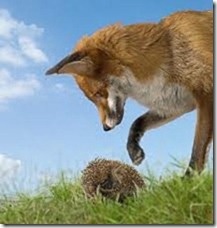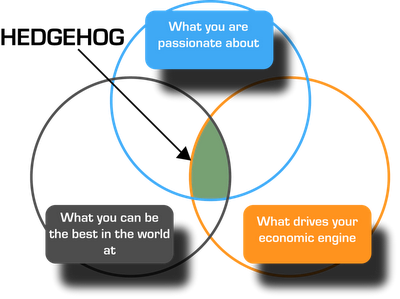The Hedgehog Concept

A Little Background
For those of you already familiar with “Good to Great”, certainly the Hedgehog Concept is perhaps the easiest to remember. In relation to all the other areas (Level 5 Leadership, First Who Then What, Confront the Brutal Facts) we have talked about so far, this idea is the most pivotal to becoming great.
Before diving in to the classic explanation of the Hedgehog Concept, let us diverge into very familiar territory. Most people remember nursery rhymes and stories from their childhood. If not, then most likely you have recently retold these stories to your children. It really doesn’t matter how you know about them, but you do. Each one of these stories has some kind of meaning even though the real meaning might have been lost years ago.
Some stories are timeless and continue to be strong. One of these stories is “The Tortoise and the Hare” by Aesop. The story is so short that I can include it here (from Wikipedia):
The story concerns a hare who one day ridiculed a slow-moving tortoise. In response, the tortoise challenged his swift mocker to a race. The hare soon left the tortoise far behind and, confident of winning, he decided to take a nap midway through the course. When he awoke, however, he found that his competitor, crawling slowly but steadily, had already won the race.
Written more than 2600 years ago the story is still going strong. What does this have to do with the Hedgehog Concept? Well, it seems very connected. In Jim Collins book “Good to Great”, the animal characters are a fox and a hedgehog. It is a new fable describing how companies look at their business. A fox, like the hare, is in a hurry to prove something without thinking about the consequences. The hedgehog, like the turtle, plods along doing what it does best not really worried about the fox.

Maintain Your Focus
The fox is easy distracted and is always thinking up new schemes. The hedgehog sticks to what it knows best and can handle adversity in a consistently positive manner.
Just like the turtle and hare, most people would pick the fox to win over the hedgehog. What is missed is that in the race of life, the duration is so long that only consistent work will win. Fast running from point to point will not win simply because the runner has no idea where they are actually headed towards.
Steady wins the race.
Even better, because the hedgehog is so focused on specific tasks, he is expert in what he does and already knows where things are going. Even if things change, he will not be off track much based on a more careful thinking than the fox.
How It Applies In Business
In the business world this could be explained this way. A fox leader is going to be looking for lots of growth and progress. To the fox leader, it really doesn’t matter how it happens as long as it does. This leads to some poor long term decisions based more on short term financial gain rather than fitting in with a simple long term way of looking at it. For example, a fox leader could acquire companies that do business in fields that have no connection with the current business. Worse than that, there might be zero passion to actually continue these businesses into what they were destined to become. If a fox leader buys a company for growth, he or she is not thinking about the long term health of the bought company. If so, it is only from the point of bringing more growth.
A hedgehog leader is more likely to be more picky when it comes to acquisition. Most likely a hedgehog leader will determine first if it fits with what the company already does and will help the company accomplish what they do best even better.
There is a great deal of insight needed to be a hedgehog leader. In other words, it is very hard to do. The first action is to determine what the companies hedgehog concept is. This takes time and is a process that can take on average four years to complete. Jim Collins illustrates this with several company examples.
Once realized, the Hedgehog Concept for you company has powerful implications. It gives focus and purpose and aligns everyone to a common sight of how things are and will be.
The book defines this as a simple crystalline concept that comes from a deep understanding of three questions.
- What can we be the best at in the world?
- What drives our economic engine?
- Where is our passion?
These questions are incredibly important to answer. The book views it as an intersection of these three questions that leads to the definition of the Hedgehog Concept.
It does make sense. These questions compel answers that are simple and strong. If a company can never be the best, cannot understand how to make money, and has not passion to do it, then it will never succeed. On the other hand, if the company knows what it is best at, knows the economics to make a profit, and is highly passionate about the business, then it is going to be a real powerhouse in the industry.
The Bottom Line
The message, in other terms, is to KNOW what you are or will be the best at. It does nothing to state a vision or a goal, you have to already KNOW what you are best at or will be. This point was stressed and it also makes sense. You cannot boast that you will be the best at something when in reality that will never happen. It’s difficult to explain so I suggest you read the book on this topic.
The economics (profits) need to be understood based on profit per thing. This one definition shifts how the business is run. If the profits are based on per customer visit, for example, obviously you would want to investigate how to make the most money per visit. Perhaps convenience and service could be help. The point is that once you know your profit point, you can work on things to improve it. Likewise, if it is deemed unprofitable based on this metric it should not be done. Keep in mind that this metric will be hard to define at first. Most obvious ones are also the wrong ones.
Passion is the energy that drives being great. If you do not believe in your company and products or services then there is little hope that customers will either. In other words, passion for growth and money is not the same thing as being passionate about the business. Passion is what holds it all together. Perhaps it is easy to see that a hedgehog has passion for his simple one thing versus a fox which has lots of energy but no consistent passion. A hedgehog leader is like a strong consistent fire whereas the fox leader is more like a flash fire. Short term the fox looks better. Long term, the burning fire still burns with the passionate hedgehog.
The team that researched “Good to Great” found some surprises along the way. First of all, having a strategy had no effect on being great or not. Everyone has strategies. Having strategies that fit the Hedgehog Concept questions is another matter. Secondly, the great companies came from all different ranges of business. In other words, it didn’t matter what kind of business you are in, it still applies and you can still get great results compared to ANY company.
Coming back to my own world, I will confess that I am more like a fox or hare. This comes from years of conditioning since… well, I don’t know when. Every once and awhile I sense things like a hedgehog/turtle and good things happen. However, patience can be difficult. It seems more exciting to be racing around chasing fires. Perhaps the strongest reason to be a hedgehog is that it gives you consistency and the realization that you are the best at what you do. In theory life would be more rewarding and also more simple.
